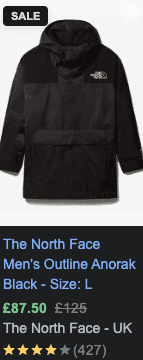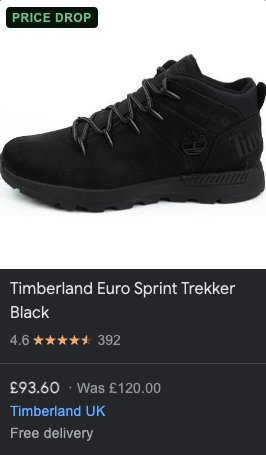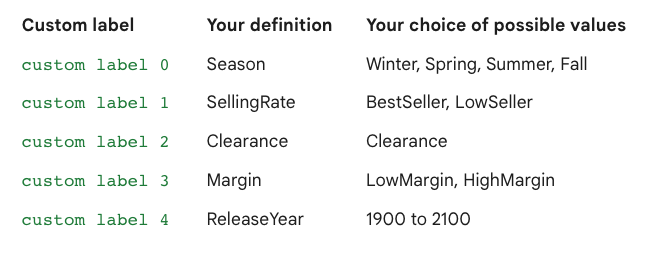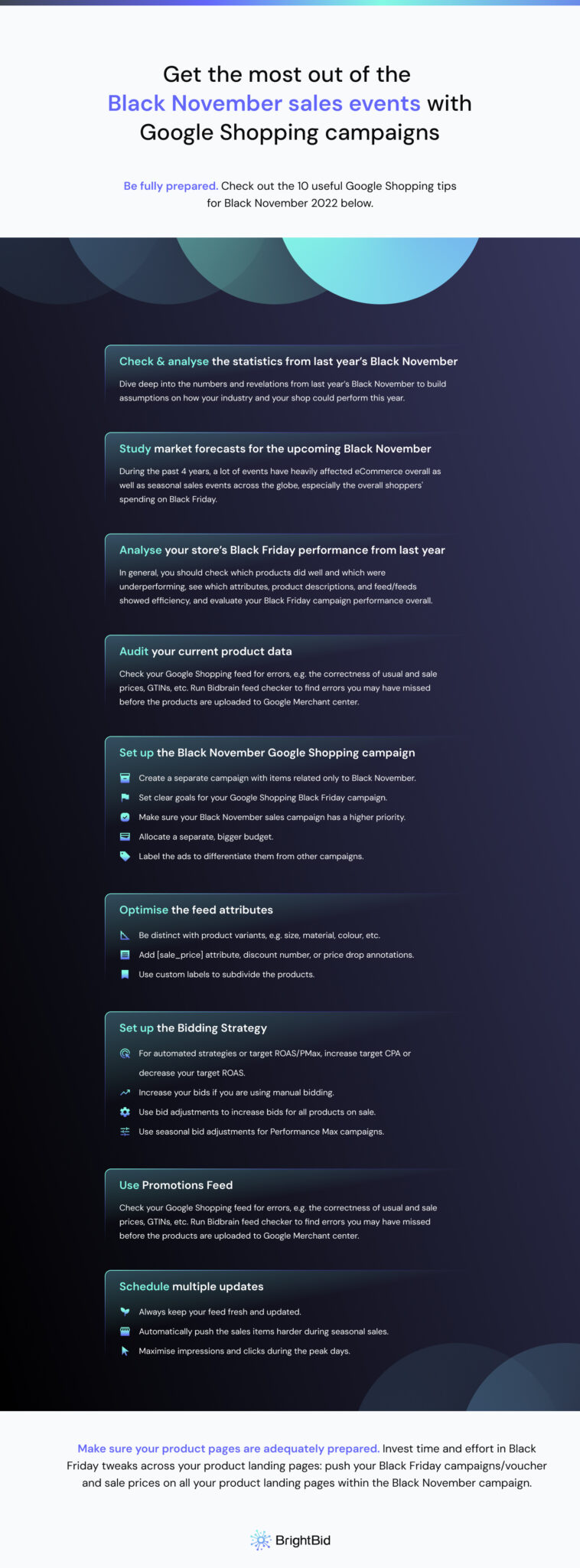Black Friday närmar sig redan. För att få ut det mesta av Black November-rearna med Google Shopping-kampanjer måste du vara helt förberedd. Kolla in de 10 användbara Google Shopping-tipsen för Black November 2023 nedan.
Innehållsförteckning
Tips #1. Kontrollera och analysera statistik från förra årets Black November
Dyka ner i siffror och uppenbarelser från förra årets Black November först och främst. Detta hjälper dig att bygga mer eller mindre rimliga antaganden om hur din bransch och din butik i synnerhet kan prestera under den kommande kedjan av rea-evenemang i november. Här är några bra källor med bra saker att tänka på:
- 36+ Black Friday-statistik 2023 (Trafik, Försäljning & Mer)
- Storbritanniens Black Friday-marknadsrapport 2023
Skynda dig inte att dra slutsatser efter att ha grävt i alla siffror och statistik för det senaste året (se tips #2, #3 och #4).
Tips #2. Studera marknadsprognoser för den kommande Black November
Tillsammans med statistiken från förra året, studera och undersök prognoserna och förutsägelserna för årets Black November. Under de senaste fyra åren har det hänt mycket, och det har påverkat e-handeln totalt sett samt säsongsbetonade rea-evenemang över hela världen.
För att uttrycka det milt sagt har vi bevittnat en minskad stabilitet, så att försöka se framåt och förutsäga vad som kan hända är en nödvändighet nu, inte ett extra alternativ, särskilt när det gäller att prognostisera prestandan för en specifik bransch eller de totala utgifterna på Black Friday från shoppare.
Tips #3. Analysera din butiks Black Friday-prestanda från förra året
För att få en framgångsrik Black November 2023 är det viktigt att analysera hur din butik presterade på Black Friday förra året. Här är tre viktiga saker att tänka på:
Produktprestandaanalys
- Ta reda på vilka produkter som sålde bäst under förra årets Black Friday. Leta efter mönster i produktkategorier eller specifika artiklar som konsekvent sålde bra.
- Identifiera produkter som inte uppfyllde dina försäljningsförväntningar och förstå varför de underpresterade. Faktorer som prissättning, presentation eller konkurrens kan vara orsaken.
- Utvärdera hur väl du hanterade ditt lager förra året. Tog populära artiklar slut för fort, eller hade du överskottslager på produkter som inte sålde bra? Denna analys kan hjälpa dig att förbättra dina lagerhanteringsstrategier inför kommande Black November.
Analys av attribut och produktbeskrivningar
- Granska de attribut du använde för dina produkter i dina listningar. Fanns det specifika attribut som lockade till sig fler klick och konverteringar? Till exempel, påverkade det produktens synlighet och försäljning positivt att inkludera detaljer som storlek, färg eller speciella funktioner?
- Analysera produktbeskrivningarna du använde för dina listningar. Var de tydliga, informativa och lockande? Bedöm om vissa typer av produktbeskrivningar ledde till bättre konverteringsgrader.
- Utvärdera effektiviteten i ditt produktflöde eller dina produktflöden. Se till att din produktdata är korrekt, uppdaterad och väls strukturerad. Överväg att optimera ditt flöde baserat på prestandan för olika attribut och produktbeskrivningar.
Utvärdering av den totala kampanjprestandan
- Utvärdera prestandan för din Black Friday-kampanj genom att titta på varifrån din trafik kom, till exempel Google Shopping-annonser, organiskt sök, sociala medier eller andra kanaler. Denna information hjälper dig att fördela din marknadsföringsbudget effektivt inför nästa år.
- Beräkna konverteringsfrekvensen för dina Black Friday-kampanjer för att se vilka som presterade bra och vilka som behöver förbättras.
- Analysera den totala avkastningen på investeringen (ROI) för dina Black November 2022-kampanjer genom att ta hänsyn till annonsutgifter, produktkostnader och genererade intäkter. Identifiera de kampanjer som gav den högsta ROI:n och gör justeringar för att öka lönsamheten.
Genom att analysera din butiks tidigare Black Friday-prestanda kan du fatta välgrundade beslut och optimera dina strategier inför Black November 2023. Denna datadrivna strategi hjälper dig att dra nytta av dina styrkor, ta itu med svagheter och uppnå större framgång under denna viktiga shoppingperiod.
Tips #4. Granska dina aktuella produktdata
Att granska dina aktuella produktdata är ett kritiskt steg i förberedelseprocessen för Black November 2023. Denna process innebär att noggrant granska och säkerställa riktigheten av den information du planerar att presentera på Google Shopping.
Dataexakthet och integritet
- Granskning av produktflöde: Börja med att granska ditt produktflöde, som utgör grunden för dina Google Shopping-annonser. Leta efter eventuella fel eller inkonsekvenser i dina produktdata. Se till att produkttitlar, beskrivningar, priser och andra attribut är uppdaterade, korrekta och följer Googles riktlinjer.
- Prisnoggrannhet:
- Kontrollera att både ordinarie pris och reapris är korrekt angivna. Eventuella diskrepanser kan leda till förtroendeproblem med potentiella kunder och resultera i förlorade försäljningsmöjligheter.
- GTIN-nummer (Global Trade Item Numbers):
- Om dina produkter kräver GTIN-nummer, dubbelkolla att dessa unika identifierare är korrekt kopplade till varje artikel. Korrekta GTIN-nummer förbättrar produkt igenkänning och kan positivt påverka din produkts synlighet på Google Shopping.
Använd BidBrain för att kontrollera flödet:
- Använd verktyg som Bidbrain Feed Checker för att skanna ditt produktflöde efter fel som kan ha missats. Detta automatiserade verktyg kan snabbt identifiera problem relaterade till produktdata och hjälpa dig att åtgärda dem innan du laddar upp ditt flöde till Google Merchant Center.
- Flödeskontrollen kan hjälpa till att upptäcka diskrepanser i produkttitlar, beskrivningar, priser och attribut, vilket säkerställer att dina produktlistor är i optimal kondition innan de publiceras.
Dataunderstödd beslutsprocess
- Genom att säkerställa kvaliteten och noggrannheten på dina produktdata hamnar du i en bättre position att fatta datadrivna beslut. Korrekta data ger en solid grund för att skapa effektiva annonskampanjer och förbättra den totala prestandan.
- Det här steget är avgörande för att anpassa ditt produktutbud till marknadstrender, kundernas förväntningar och den kommande Black November-prognosen för 2023.
Prestandaförväntningar
- Korrekta produktdata påverkar direkt prestandan för dina Google Shopping-kampanjer. När dina produktlistor är felfria och väloptimerade är det mer troligt att du lockar till dig potentiella kunder och driver konverteringar under Black November-rean.
- Konsekvens och noggrannhet i produktdata förbättrar också din butiks trovärdighet och pålitlighet, vilket gör att kunderna är mer benägna att välja dina produkter framför konkurrenternas.
Att granska dina aktuella produktdata är en viktig del av din förberedelse inför Black November. Det garanterar att dina produktlistor är korrekta, uppdaterade och uppfyller Googles krav. Genom att vidta dessa åtgärder kommer du att vara väl förberedd att göra välgrundade antaganden om din butiks prestanda under den kommande Black November, och du maximerar dina chanser till framgång under denna kritiska shoppingperiod.
Tips #5. Sätt upp Google Shopping-kampanjen för Black November
Nu när du är väl rustad med kunskaper och insikter inför Black November och har fixat all produktdata för din butik, är det dags att skapa Google Shopping-kampanjen för Black Friday. I grund och botten bör du göra följande:
- Skapa en separat kampanj med endast artiklar som är relaterade till Black November. För enkelhetens skull, skapa gärna flera kampanjer om du inte bara siktar på Black Friday utan även på Cyber Monday, St Andrews Day eller någon annan helgdag eller rea som inträffar runt samma tid som Black Friday i ditt land eller din region.
- Sätt upp mål för din Google Shopping Black Friday-kampanj. Bestäm tydligt vad du vill uppnå med kampanjen, t.ex. öka intäkterna, bli av med osålda varor osv.
- Se till att din Black Friday-kampanj har högre prioritet än vanliga kampanjer.
- Avsätt en separat, större budget. Blanda inte pengarna du spenderar på Black Friday-kampanjen med din totala budget.
- Märk upp annonserna på rätt sätt för att skilja dem från andra kampanjer.
Tips #6. Optimera feed-attributen för Black November
Titlarna och beskrivningarna på de produkter du pushar via Google Shopping till dina potentiella kunder bör vara helt optimerade för Black Friday-rean.

När du lägger till titlar på dina produkter i Black Friday-katalogen, var noga med att skilja på titlarna för produktvarianter, till exempel storlek, material, färg osv. Se ett exempel på en bra produkttitel för Google Shopping ovan.



Använd attributet “[sale_price]” (reanpris), rabattprocent eller prisnedgångsanmärkningar för att framhäva priset före och efter rea.

Anpassade etiketter: I Shopping-kampanjer kan du använda anpassade etiketter för att underindela produkterna i din kampanj med valfria värden. Du kan till exempel använda anpassade etiketter för att markera att produkter är säsongsbetonade, utförsäljning, bästsäljare osv. Med Bidbrain kan du använda ett obegränsat antal anpassade etiketter.
Tips #7. Välj rätt budgivningsstrategi
Det finns olika metoder för budgivningsstrategier för Black Friday i Google Shopping.
- If you are using automated strategies or target ROAS/Performance Max, increase your target CPA or decrease your target ROAS.
- Höj dina bud om du använder manuell budgivning
- Budjusteringar för att höja buden på alla produkter som är på rea.
- Säsongsjusteringar för budgivning i Performance Max-kampanjer.
Under de senaste åren har AI blivit riktigt bra på att optimera och implementera budgivningsstrategier för annonser. Exempelvis kan du med Bidbrain AI-budgivning:
- Maximera avkastningen på annonskostnader för varje produkt.
- Aktivera produkter utan historiska data – Bidbrains aktiveringsalgoritm hittar de gömda topprodukterna i ditt flöde.
- Konfigurera dina produktsegment så att AI:n kan arbeta mot anpassade mål-ROAS eller POAS (Profit On Ad Spend).
- Få tillgång till helt transparent data som tillhör dig och hjälp med att visualisera budgivnings- och sökordsdata på produktnivå.
- Maximera din ROAS och ge dig full kontroll över dina försäljningsvolymer.
- Använd Bidbrains kampanjtyp “Sale Push” som maximerar det dagliga antalet produktvisningar – denna kampanjtyp justerar buden per timme för att hitta den perfekta nivån.
Vårt kundtjänstteam hjälper dig gärna att utveckla den bästa budgivningsstrategin för dina behov.
Get the Most Out Of Your Shopping Ads
Tips #8: Använd kampanjer via feed

Prova att använda en kampanj-feed som specificerar vilken kampanj varje produkt ska tillhöra. På det här sättet behöver du inte ändra huvudfeeden för produkterna varje gång du vill lansera en kampanj. Produkter från en kampanj-feed kommer även visas i dina annonser och kan få dina produkterbjudanden att sticka ut.
Tips #9. Schemalägg flera uppdateringar
Under stora säsongsevenemang, som Black November, tar lagret ofta slut snabbt. Därför är det viktigt att hålla ditt flöde uppdaterat. Med Bidbrain kan du:
- Alltid hålla ditt flöde uppdaterat och fräscht.
- Automatiskt pusha reaartiklar hårdare under säsongsrean.
- Maximera visningar och klick under toppdagarna.
Tips #10. Se till att produktsidorna är redo
| Klassificering | Transaktioner | Procentandel |
| Faktisk produkt | 41 | 45.05% |
| Annan kategori | 28 | 30.77% |
| Annan produktvariant | 12 | 13.19% |
| Liknande produkt | 10 | 10.99% |
Källa: SavvyRevenue
Statistik visar att upp till 60 % av produkterna på Google Shopping leder till att kunden köper en annan produkt än den de klickade på. Det betyder att du bör lägga ner tid och ansträngning på att justera dina produktsidor inför Black Friday: lyft fram dina Black Friday-kampanjer, rabattkoder och reapriser på alla dina produktsidor under hela Black November-kampanjen.

 ” />
” />
 ” />
” />
 ” />
” />
 ” />
” />
 ” />
” />
 ” />
” />